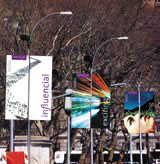Brand building on the curriculum
Merged colleges are setting a branding trend for the UK’s higher education sector, says Sarah Balmond

There used to be a time when a university simply slapped a logo crest across all of its communications and passed it off as a ‘successful’ brand identity. But these days, stiff competition, brand-savvy students and changing educational laws – such as the right for universities to charge British Students up to £3000 a year come 2006 – are forcing many of the UK’s leading institutions to up their game.
The newly merged University of Manchester, University of Sussex, University of Sheffield, University of Birmingham, Open University and Thames Valley University have all recently undertaken projects to refresh their identities, enlisting designers to help them carve out a place in the increasingly crowded academic marketplace. The projects tend to be vast in scope and briefs are complex, but consultancies are rising to the challenge and creating sophisticated work that attempts to go much deeper than devising a simple visual identity.
A case in point is the new University of Manchester, created by the merger of the Victoria University of Manchester and nearby University of Manchester Institute of Science and Technology. The institution unveiled its entire brand architecture, created by design consultancy Lloyd Northover, last week (DW 28 October).
Reported to now be the largest university in the UK, the institution hopes to establish its status as a ‘super-university’ through this newly created visual language. The identity engages with a disparate audience and addresses the implications of increasing customer choice, according to Jim Bodoh, director at Lloyd Northover. ‘Universities are by definition very complex and it’s a real challenge to translate this into a simple, compelling brand concept,’ he says.
Currently, the consultancy is also carrying out work for Thames Valley University, which recently merged with Reading College. The project is still in the research stages, but Bodoh says he plans to launch the new identity by February next year.
Lloyd Northover has worked for some 15 universities on a wide range of branding and communications projects since 1990. Bodoh says universities’ attitudes toward the benefits of marketing have changed over the years, generating a need for more sophisticated design and branding solutions.
‘Ten years ago, universities were perhaps not so convinced of the need for effective branding and there were pockets of resistance,’ he explains. ‘Academics may have identified more with their own disciplines and set of values rather than the institution as a whole. But this is changing, in part because of competition and fees, and there is now a growing support and commitment among universities for more cohesive identities,’ he adds.
Across the sector universities are having to apply branding more strategically, ‘to really think about their value and what makes them special’, says Bodoh. ‘The challenge is then to translate this into a visual format.’ He concludes, ‘The higher education sector has seen the need to invest more in design and has begun building in-house communication, marketing and branding teams to meet these growing demands.’
One such example is the University of Sheffield. It launched a new department 18 months ago, appointing its first design manager, Robert Hurst, to head up a team tasked with redeveloping a brand identity for the organisation (DW 28 August).
The university hopes to entice a greater number of students, build its reputation and ultimately leapfrog up the much-referenced league tables with the introduction of a revamped identity, which will be unveiled later this year.
‘This is the first time we’ve tried to create a consistent brand and identity for the university,’ says Hurst, ‘but more than that we are trying to change the perception and behaviour of the university.’
While applauding the sector’s efforts to refresh brands, Hurst questions the validity of some recently-launched identities. He speculates, ‘There seems to be a lot of the “me too” mentality out there. Many universities seem to be rebranding, but how much of this the work is merely cosmetic and what do they really gain from it?’
The University of Birmingham, which appointed Wolff Olins to its first major brand redesign project following a pitch in January, has very clear views about what it hopes to achieve through its new identity. ‘The organisation was far too complacent in its public image. Birmingham had an outdated public perception that lagged behind reality. We needed to up our game,’ says Sue Primer, head of communications at the University of Birmingham.
The identity will be unveiled next year, but Nigel Markwick, senior consultant at Wolf Olins, hints that the look will be ‘edgy and have an attitude’. It will be based on the brand proposition ‘Provoke’.
The University of Sussex recently launched its new brand ‘US’ created by Blast (DW 11 March). The identity uses a marque that can be adapted for marketing purposes, says Colin Gifford, creative director at Blast. Gifford believes universities are now aligning their identities in a more holistic way, attempting to break away from a design heritage that traditionally adopted heraldic devices and crests.
It seems no academic institution can afford to be complacent when it comes to branding. Redesigning an identity is ultimately a long-term investment and can prove pivotal to an organisation’s survival. Designers are reaping the benefits of this educational revolution.
-
Post a comment




